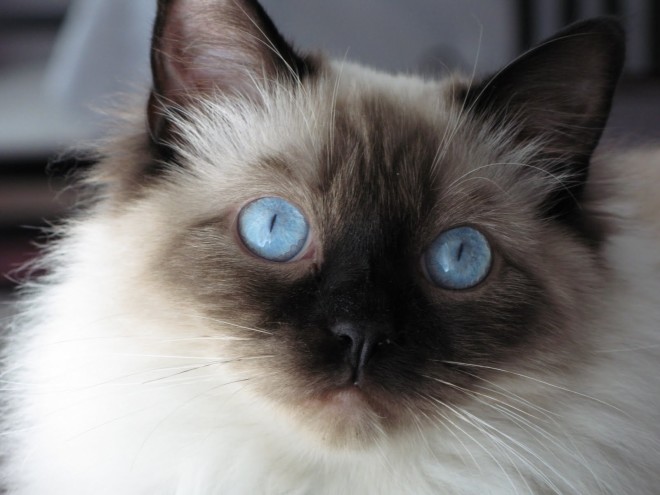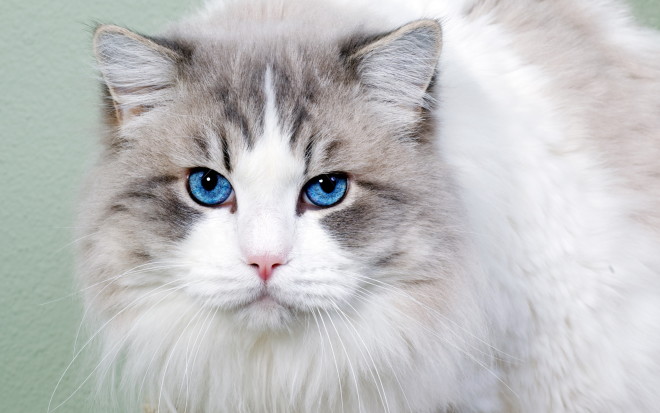Blue-eyed cats
The blue color of the eyes in cats is associated with the content of cells of a special pigment in the iris of the eye. These cells are called melanocytes. There are two layers of the iris containing melanocytes. The outer layer - the stroma - contains loosely packed melanocytes, the innermost layer, located closer to the back of the eye, contains tightly packed melanocytes.
The number of melanocytes in the stroma is responsible for eye color, a high amount of pigment granules gives a brown / copper eye color, a smaller amount of melanocytes gives a green eye color, and quite a small amount of melanocytes gives the blue color of the eyes. The complete absence of melanocytes leads to the fact that the color of the eyes becomes red (like in real albinos). The blue color of the eyes can range from pale blue to dark blue royal.
All kittens are born with blue eyes, and if their eyes change color, it usually occurs at the age of 4-12 weeks.
There are three common reasons why a cat can have blue eyes
1. Domination of white (epistatically white cats) - the gene responsible for the white color of the cat and its blue eyes symbolically denoted by the letter "W". It is dominant, and therefore only one copy of it is necessary in order for the offspring to inherit these features. This gene oppresses the possibility of producing a pigment. This means, for example, that you have a genetically black (or red) cat, but if it is a carrier of the W gene, its color will be masked. White cats with blue eyes are often deaf, as the W gene also affects the development of acoustic cells.
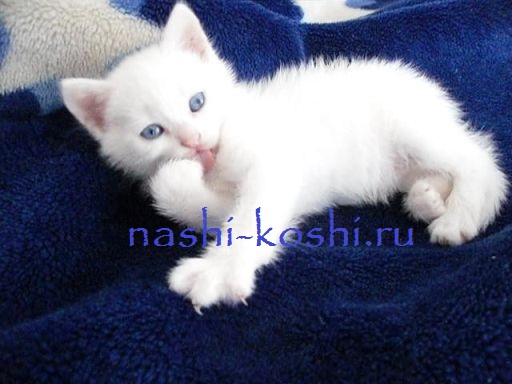
2. Albinism - there are five known albino alleles in cats. Solid color (C), Burmese (cb), Siamese (cscs), blue-eyed albino (caca), albino with red eyes (ss). Of all the albinos, only Siamese cats (cscs) and blue-eyed albinos (caca) have blue eyes.
The gene responsible for Siamese and other colorpoint colors (cscs) is recessive, which means that the offspring should inherit this gene from each of the parents. In Siamese cats / colorpoints, this gene causes partial lightening of the color from black to dark brown, called the Himalayan mutation.
The gene makes the color of the cat thermally sensitive, so that the end parts of the cat (limbs, ears, tail) remain dark, and the body - from white to cream.
Blue-eyed albinos differ from the epistatically white cats in that the latter is masked by the W gene. Blue-eyed albinos have a white color due to a lack of pigment, and not because of color disguise.
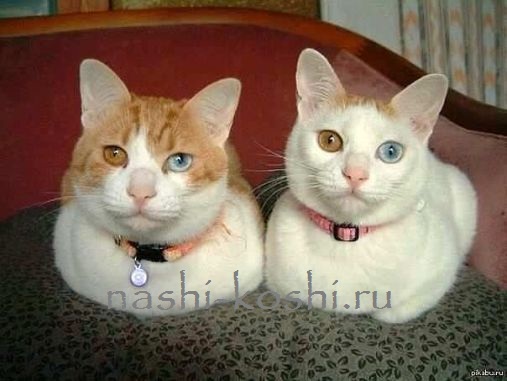
Such phenomenon as heterochromism - a different color of eyes, arises from the fact that the cat's eyes fall into the different colored areas that arise from the migration of melanocytes. If the eyes fall into the area to which the melanocytes have reached, they will be blue. If the eyes fall into different areas, then only one eye will be blue.
3 . White spotting (Pegost, S gene) - cats with white spots are very common, the amount of white can occupy from 100% of the surface of the body, to tiny spots called medallions. If white areas are located near the eyes, the eyes will be blue.
4. Ojus Azules (gene So) - this is an extremely rare cats with colored color and blue eyes. Unlike blue-eyed Siamese cats that may be prone to squinting, and epistatically white cats that may be deaf, in cats, the asus of the gene does not affect vision and hearing. However, in this case the gene causes other congenital problems in the homozygous form (i.e.
A gray cat is a common type of these pets. Genetically, any gray cat is an individual of clarified black color. Uniformly black (true or clarified) fur coat in the animal is rare, it is often supplemented with white, more rarely - red (bicolor) or several colors (tortoiseshell and other variations).
Gray kitten often has a fuzzy blurred pattern of spots and stripes on the coat - this is the color of a tabby. Changing the "children's" fur, the animal becomes the owner of a uniformly painted fur coat. If the picture is clear, then it is preserved and becomes brighter with age.
Types of gray cat's color
Evenly ashen is often called blue: in bright sun the fur coat really casts light blue. Under moonlight, a gray cat appears to be an ink or a deep graphite color. Another version of the clarified black is smoky. The kitten's kitten is painted evenly, with a light coating.
Breeds of gray cats
Abyssinian and Somali cats have blue color - one of four allowed. Typical Abyssinian color - "wild" with yellow eyes.
Blue is inherent in the Australian mister. The second name is Australian smoky, because this color is original. Felinologists subsequently received a ticked mauve (pink-blue), as well as other interesting tones in the palette of the breed.
Asian tabby is a new breed. He has on the main background patterns from a differently colored wool, a pattern on the forehead in the form of the letter "M", a stroke of the nose and eyes, a picture on the ear in the form of a fingerprint. Grayish tabby has golden, copper or orange eyes.
American, Karelian, Kurilian and Japanese Bobtails allow artificially obtained bluish coloration. The initial color of bobtails is beige or fawn with brown tabby.
American shorthaired and short-haired cats are representatives of the same type. Their kittens are sometimes born gray: the fur on the sun is pale and only slightly casts bluish.
American curl - looks unusual due to bent out ears. The wool is colored variously: in blue, silver-blue, smoky blue, dark gray and other variants - evenly and with tabby.
Anatolian or Turkish short-haired cat aboriginal. Can be of deep lead or just blue color, monophonic or with tabby and ticking.
The Arabian Mau is not recognized at the international level. Clarified black kittens Arabian mau is rare and not typical.
Balinese or Balinese, Himalayan, Siamese and thai cat, and also ragdoll and snow-shu have color-color point. The body is light (ideally white), muzzle, tail, tips of paw-points - dark, equally colored, without white spots and hairs. Points are dark gray, almost black, and blue.
The Bengal breed recently received the right to officially wear blue as a background, on which black and brown streaks of a characteristic marble tabby are located.
Brazilian short-haired - also aboriginal pussy with a fur coat of any color, including all shades of gray: from dark to silvery-blue.
British and Scottish pets are common all over the world. Classic are blue and blue and white (bicolor). On the blue, clear spots and tabby stripes are welcomed.
Burma or Burmese cat, too, is blue and wears white "socks" on its paws.
Burmilla is a very beautiful and sociable cocktail. Its wool coat can be blue along with others, while the undercoat is golden or silver.
Devon Rex has a rare curly hair and smoothly adjacent to the body of the undercoat. A blue undercoat is allowed, but it is preferable to purple. In the Cornish Rex, the undercoat curls into tight rings and is painted in the same way as in the Devonian Rex. The same applies to the German (Prussian) Rex.
Don and Canadian sphinxes, Ukrainian lefthand and other woolly. They have a pigmented skin, and not thin thin hairs. Colors are determined by skin pigmentation. All are allowed, including deep gray and blue.
European Shorthair is bred in different colors: including dark gray, blue, purple. The cat is either evenly colored or has a tabby.

Egyptian Mau is a very beautiful and effective cat. To fix the breed colors (silver, bronze and smoky), otherwise colored kittens are rejected. Smoky have a dark woolly covering coat and a silver undercoat dark to black.
The California shining cat is an amazingly beautiful animal with a long or half-long very shiny coat. The location of the spots on the main background (blue is allowed) makes the animal look like an ocelot.
Kimryk is like a bear cub because of a short tail, thick long fur and a lush collar. Kimryk is bred in various colors: including evenly ashy or in a duet with white.
Korat according to the standard is allowed in breeding only in a silver-blue fur coat, where each wool is dyed evenly gray, and the tip is silvery at the same time. It creates a wonderful tone, dazzlingly beautiful in the sun.
Laperm and Ural Rex are distinguished by their curls: preferably light, shaded or smoky, including blue.
Munchkin is a very unusual smoky cat. Taurus reminds them of the body of the dachshund - long on short legs, and the standard includes all the colors. Effective expressive ash and other smoky colors, as well as tabby on a solid blue background.
Maine Coon is the largest smoky cat. This is an aboriginal breed with a variety of colored woolens. Black and red representatives predominate. But there are light-blue, smoky-blue, silver-blue and blue shaded. Solid blue - a rarity, more often stains and streaks on the head and paws, because in nature
Maine coons had a tabby pattern. Sometimes with the gray color of fur they are associated with polycystic kidney disease.
Minskin is an experimental dwarf naked cat. The woolen cloths grow on her back and sides, very thin and thin. Skin pigmentation is anything, including grayish in all shades.
Napoleon is a gray striped cat of a tiny size. They have plush wool, which does not require care.
The Nibelung has a luxurious long coat of a rich and only possible blue color with silver tint. Shorthair Russian blue has the same color restrictions.
Norwegian forest and Siberian cats have a waterproof long coat of any tone, including gray, and a fluffy tail.

Ocicat is like an ocelot, like California shining, but with the only difference that the permissible shades of the blue are wider - smoky, purple, silvery, deep.
Tonkinskaya cat has a light gray without reflux and blue colors, reminiscent of the quality and density of fur mink.
The French breed Chartreuse is allowed to breed if the color is pure gray, smoky or silver.
Peculiarities of color
The nature of the fact depends little on coloring, but it is believed that gray individuals are the most intelligent and flexible. Genetically associated with the clarified black gene of disease is small: usually polycystic kidney disease and retinal diseases.
Gray cats are often credited with the abilities of healers. Whatever the animal, he needs love, care and competent care.
Related Videos
Green and yellow are the most common eye color in cats. Much less often there are blue-eyed cats, because they are very much appreciated among breeders. As geneticists have found out, the gene that is responsible for eye color is not inherited. But there is a correlation between the color of the cat's fur and the color of its eyes. The presence of blue eyes in a cat is associated with a special pigment on the iris of the eye. Such cells are called melanocytes. Their number in the outer layer of the eye is responsible for the color. The greatest number of pigments gives brown, yellow, copper shades, the average number is green, and very small - rare blue eyes. When melanocytes are absent, red eye shades are completely obtained, as in albinos. Blue shades of eyes range from royal dark blue to pale blue.
All kittens are born with blue eyes, which can later change their color, usually in 4-12 weeks.
Below is a list of reasons for the appearance of blue eyes in cats.
White color domination
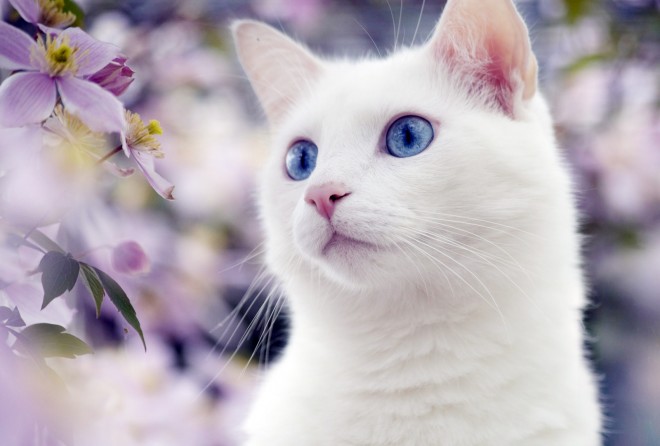
Blue eyes are most common in cats with a white color. It is believed that in white cats, the saturation of the blue color of the eyes is distinguished by its incredible depth. But white cats do not need to have a blue eye color, they are often colorful. Heterochromia - a different color of the eyes in a cat, which occurs as a result of placing the eyes on sections of wool, differing in color. Often, white cats may suffer from deafness, this is due to the presence of the W gene, which is responsible for color.
Siamese color
It is worth knowing that this color is characteristic only for cats of Thai or Siamese breed. In modern classification there are about 25 breeds for which this color is peculiar. The saturation of the blue color of their eyes has a different degree depending on the color of the coat. For example, in cats with the type of force-point color, a brighter shade of the eye, up to blue, and the eyes of a cat with the color of wool, lilac or tabby point, have faint blue hues.
Albinism
There are also blue-eyed albino cats. Albinism is inherent in cats with a special genetic code "caca". This gene can also be present in Siamese cats and is called "cscs". The presence of this gene is represented by the prominence of the hair and the heavenly shade of the eyes. Clarity occurs due to the sensitivity of the color to the temperatures.
White spotting
Such cats are also called pegi, they are quite common. It can be cats of tortoiseshell color with rare white specks. Such tiny spots are called "medallions". Eyes will be blue if white spots are located in the eye area.
Ojos Azules
There is such an extremely rare breed of cats as Ojos Azules (genetic code So). They have colored color and blue eyes. Unlike Siamese cats, they can be cross-eyed. But their gene does not affect sight and hearing in any way, but rather it is a feature of this breed. However, they often have other birth defects - irregular skull shape and stillbirth. To avoid this, it is advised not to cross them with blue-eyed cats; this gene is transmitted from one parent.
Thai, Balinese, Burmese, Javanese, Ojos Azules, Siamese, Regdoll, Himalayan, Snow-shu, Kao Mani and Turkish Angora.
Breeds of cats whose blue color depends on the color: American and Japanese Bobtail, Munchkin, Devon Rex, Cornish Rex, British, Maine, La Perm, Persian, Ragamuffin, Bengal, Scottish Fold, Van.
Cats with black color and blue eyes are almost never found.
In addition, we offer you to watch an interesting video about the eyes of people and animals
The blue eyes of a cat are not only very beautiful, but also the result of rather complex processes in the animal's body. Some breeds of cats can, or even have to, have blue eyes, whereas others can not have them at all.
Blue-eyed cats have always been considered something of a cat-like aristocracy - I know everything about it. However, with what such color of eyes is connected the few know. The reason for this is the maintenance in the iris of the eye cells of a special pigment. These cells are called melanocytes. They are contained in two layers of the iris. In the innermost layer, which is closer to the back of the eye, there are densely packed melanocytes, and in the stroma - the outer layer - they are loosely packed with melanocytes.
The number of melanocytes in the stroma is responsible for the color of the iris, and a high number of pigment granules gives the eyes a copper / brown color.
If the number of melanocytes is less, the eyes become green, and if they are very few, the eyes will be blue. In the case of the complete absence of melanocytes, the eyes become red like albinos. As for the blue color of the eyes, it can range from a pale blue to a dark blue royal color.
It is worth recalling that all the cats have blue eyes for a short time after birth, and after 4-12 weeks their color begins to change, if, of course, it changes at all.
 Ragdoll
Ragdoll There are three main reasons that give the cat blue eyes
- White domination (the so-called epistatic white cats) - the white color responsible for the white color, as well as for blue eyes, is conditionally denoted by the letter W. This gene is dominant and in order for the offspring to inherit these signs, one copy of it is enough. This gene inhibits the production of pigment. In other words, if you have a genetically ginger (or black) cat, but is the bearer of the W gene, then its color will be disguised. And since this gene influences the development of acoustic cells, white cats are often completely or partially deaf.
- Albinism. There are five albino alleles in these animals: albino with red eyes (ss), blue-eyed albino (sasa), Siamese albino (cscs) Burma (cb) and solid color (C). Blue eyes among all albinos have only blue-eyed albino (sasa) and Siamese cats (cscs).
The gene that is responsible for colorpoint colors, including the Siamese (cscs) is recessive. From this it follows that the offspring should inherit this gene not from one, but from each parent. In color-points / Siamese, this gene leads to a partial lightening of the color from black to dark brown, which is called the Himalayan mutation. This gene makes the animal's color heat-sensitive, so that the end parts of the cat, such as the tail, ears and limbs, remain dark, while the body becomes lighter in color from white to cream.
Blue-eyed albinos have from epistatic white cats the difference that the latter gene W masks color. In other words, blue-eyed albinos are white not because of the absence of pigment, but because their color is masked.
Different eye color - heterochromia - arises from the fact that the cat's eyes have got into the variegated areas that appear due to migration of melanocytes. If the eyes are in the area that melanocytes have reached, they will have a blue color, and if they are in different areas, then only one eye will have their blue color. - Pest (white spot, gene S). Cats with such a spot are very common, and the amount of white can vary in a very wide range - from tiny patches, called medallions, to a completely white surface of the body. And if the white areas are near the eyes, then the eyes will have a blue color.

In addition, it should also be noted the breed of the hunting Azules with its inherent So gene. This breed is very rare, has blue eyes and color. Unlike the blue-eyed Siamese, who have a tendency to squint, and also unlike the epistatic white cats, which often turn out to be deaf, the gene for hunting does not affect either the ear or the eyes. But this gene can carry other genetic problems if the cat has two copies of a gene inherited from each parent, such as stillborn offspring or skull defects. To avoid such problems, the Azules should not be crossed with cats with blue eyes.
48A charming, angelic cat with blue eyes is the dream of many. Finding such an aesthetic animal in open access is very problematic. Blue-eyed cats quite rare and highly valued. Therefore, the desire to find just such a cat, must be accompanied by the understanding that it will hardly get to you for free. Everyone knows that the color of the eye is directly dependent on the color of the iris. For blue coloring of the iris, a special pigment, melanocyte, is required, and in a certain amount. If the amount of pigment granules is high, we will get a brown or red shade of the eyes. Average - green. For the blue color of the iris, a low content of melanocytes is required. It should also be noted that the shades of blue can be a great many. The palette differs from light blue to dark blue color (royal).
And now we will take a closer look at the reasons why a cat can boast of a blue eye color. First, the dominant white gene. Most often cats, with a white color, turn blue-eyed. To them it is possible to carry, for example, the Angora cat. The white gene is designated by the letter W. As it was said in our previous materials, white cats can sometimes have a poor hearing. The fact is that gene W negatively affects the development of cells responsible for hearing acuity. But this is not always the case, so do not worry about the health of a potential white blue-eyed cat that you liked.
Secondly, if the cat is an albino. Yes, there are blue-eyed albinos. Their genetic set looks like this: Sasa. It is interesting, but the gene of albinism is present in Siamese cats and therefore their wool is partially brightened and eyes glow with a heavenly shade. Their genetic set looks like this: cscs. Clarification is due to the thermal sensitivity of the wool in certain places. By the influence of the temperature drop, the wool changes its color and the cat acquires a characteristic Siamese color.
Third, spotting. Cats with tortoiseshell color often contain a white color in their range. If a white spot is located near the eyes, the latter can intercept the gene W and acquire a blue color.
Fourthly, there is a full and special breed of cats with blue eyes. Ojos Azules was named for the generic difference of this breed - blue eyes. In this case, the cat can be multicolored. Hearing disorders, strabismus, visual impairment is not observed. Cats are unique in their kind and have always been much appreciated. However, there is one "but". Such cats are not recommended to cross with blue eyes of other breeds. Otherwise, stillbirth or mutation of the skull in kittens is possible.
We always see the blue color of the iris in the following breeds of cats:
But there are breeds of cats, the standards of which allow for different variations in coat color. As a consequence, in these breeds, different colors of the iris are allowed. Below we will present the breeds of cats that have blue eyes and their shades:
It's not all breeds of cats with blue eyes. In fact, they are somewhat larger, because felinology regularly conduct experiments and find new features of different breeds or mixtures.
According to all laws of genetics, a cat with blue eyes should be only white, or Siamese, or color-point. But from any rules there are exceptions. However, in our region, it is possible, though rare, to meet a special kitty of unusual appearance. Her eyes are blue, but her hair is black. This is a big rarity, since a uniform black color indicates a dominant black gene (B), with the eyes genetically quite opposite to the color. This breed is called "Altai blue-eyed".
We found a kitty in Ust-Kamenogorsk and immediately named it in honor of our native land. After a while it turned out that when crossing such a cat with an ordinary cat, some kittens are born with blue eyes. The only mandatory condition for the appearance of blueness in the eyes is the presence of the W gene. And it does not matter in what proportion. One white spot is enough. Even a few white hairs already give a chance to get the desired shade of the eyes. In fact, this breed is a Russian analogue of Ohus Azules, derived in his time in California.
List of cats with blue eyes is large enough. It remains only to choose the breed and color. Although the main thing, nevertheless, in the cat is not the color of her eyes or coat. To choose a suitable cat is not enough to study the characteristics of its breed. You need it to match you in character so that you like each other. And this, as you know, does not depend on the breed.

